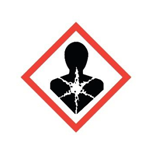Hazard Pictograms
Pictograms are classified in two set:
- Labelling of containers and for workplace hazard warnings
- Transport of dangerous goods.
Pictograms gives the following indication:
- an identification of the product;
- a signal word – either Danger or Warning – where necessary
- hazard statements, indicating the nature and degree of the risks posed by the product
- precautionary statements, indicating how the product should be handled to minimize risks to the user (as well as to other people and the general environment)
- the identity of the supplier (who might be a manufacturer or importer)
Hazard pictograms and Description:
Health Hazard: This pictogram is put on a chemical label when a substance presents these health hazards:
- Carcinogen–may cause cancer
- Respiratory sensitizer–may cause respiratory irritation
- Reproductive toxicity–may damage fertility or the unborn child
- Target organ toxicity–may cause damage to bodily organs
- Mutagenicity–may cause genetic defects
- Aspiration toxicity–may be fatal if swallowed and it enters the airways

Flame:
- Flammables–which are gases, aerosols, liquids, or solids that will burn or ignite under certain conditions,
- Self-Reactive heating alone, without air, may cause fire or explosion,
- Pyrophoric–in small amounts, may ignite within 5 minutes after contact with air,
- Self-Heating–which may catch fire only in large amounts and after long periods of time when exposed to air,
- Emitters of flammable gas, and
- Organic peroxides–which, when heated, may cause fire or explosion; may be sensitive to impact or friction; and may react dangerously with other chemicals.

Exclamation Mark:
It is used on a chemical label for substances that represent the following hazards:
- Irritant–irritates the skin or eyes;
- Skin sensitizer–which is an allergic response following skin contact;
- Acute toxicity–which may be fatal or cause organ damage from a single short-term exposure;
- Narcotic effects like drowsiness, lack of coordination, and dizziness; and
- Respiratory tract irritation.

Gas Cylinder:
This pictogram on a chemical label means that the substance is a compressed, liquefied, or dissolved gas under pressure at 29 pounds per square inch or more.

Corrosion:
Materials causing skin corrosion/burns or eye damage on contact, or that are corrosive to metals.

Exploding Bomb:
The exploding bomb pictogram appears on the chemical labels of substances that are:
- Explosives—which is a solid or liquid chemical capable of a chemical reaction that causes damage to the surroundings,
- Self-Reactive—heating may cause fire or explosion without the need for air, or
- Organic peroxides—again, heating may cause fire or explosion.

Flame Over Circle:
Identifies oxidizers. Oxidizers are chemicals that facilitate burning or make fires burn hotter and longer.

Skull and Crossbones:
Substances, such as poisons and highly concentrated acids, which have an immediate and severe toxic effect (acute toxicity).

Environmental Hazard:
Chemicals toxic to aquatic wildlife. (Non-Mandatory)

Note: Pictograms will be on the product supplier labels of the hazardous products you work with. They will also be on the SDS (Safety Data Sheet) / MSDS (Material Safety Data Sheet).
